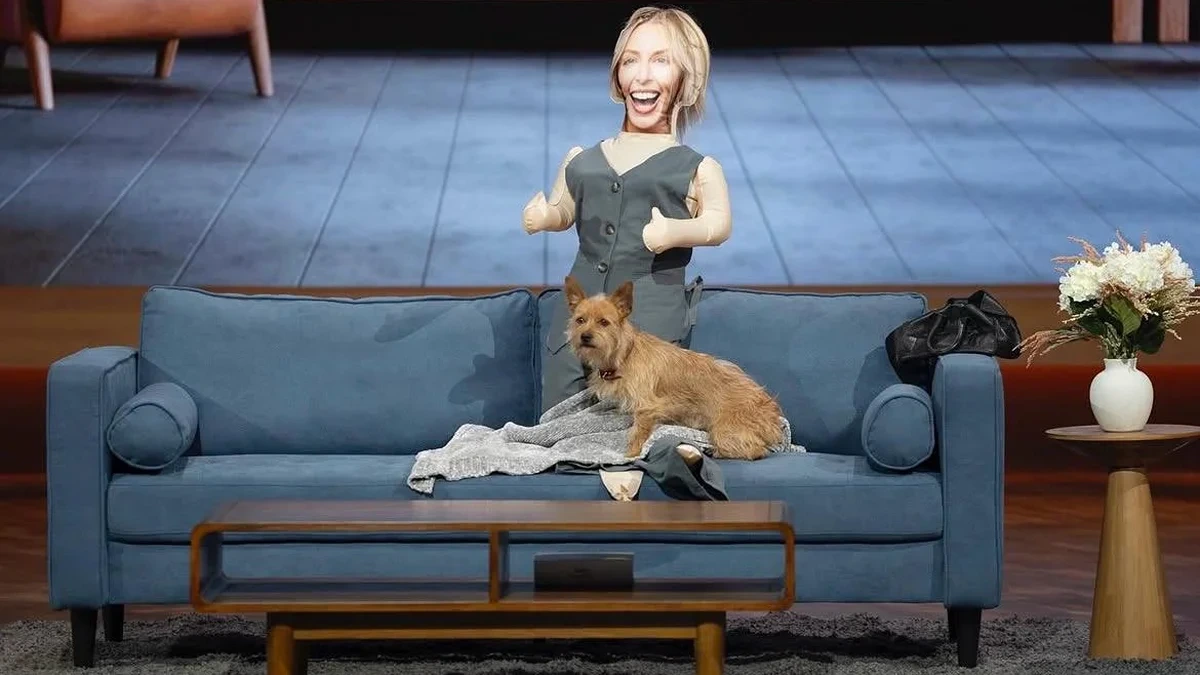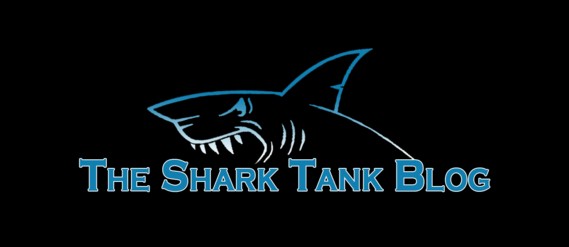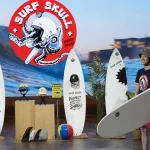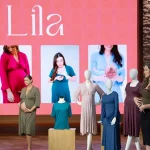
When “Shark Tank Season 17 Episode 2” rolled around, viewers expected a few quirky pitches, dramatic negotiations, and maybe a surprise win or two. What they perhaps didn’t expect was that Gerty, an inflatable, human-shaped “emotional support” doll for dogs, would become the meme trophy of the episode. But meme it did.
Within hours of broadcast, Gerty’s uncanny appearance, bizarre concept, and sheer audacity turned it from oddity into overnight internet fame. This is the story of how one unconventional pet product stole the show — and the internet’s attention.
The Pitch That Broke the Meme Bank
Todd Schram, the inventor behind Gerty: Pet’s Best Friend, walked into the Tank with a bold proposition: a lifelike, seated, human-shaped inflatable companion that dogs could cuddle with when their humans weren’t home.
The pitch opened with Todd explaining how many dogs suffer from separation anxiety, leading to barking, destruction, and stress.
Gerty, he argued, offers a comforting presence — and because it’s inflatable, it’s safe, light, and stores easily. He showed a prototype sitting upright, dressed in casual human clothes, even adorned with a hat. Then came the twist: pet owners can dress Gerty in their own worn clothing so the doll carries their scent, strengthening that sense of presence and familiarity.
As Todd pitched, the Sharks’ reactions were priceless. Some laughed Robert Herjavec Robert Herjavec joked that it looked like a ‘rubber blow-up doll business.’ Some paused in skepticism, and others leaned in, trying to assess whether there could be method behind the madness.
Scenes of Gerty seated upright in casual clothes struck a surreal, comedic chord. The mix of earnestness and absurdity made it perfect meme fodder.. Was it a pet wellness innovation? Or a quirky novelty with viral potential? The tension between product, pitch, and reaction made it perfect meme fodder.
From the moment the show aired, screenshots of Gerty posed “like a human,” staring blankly began circulating across Twitter, Reddit, TikTok, and Instagram. Memes comparing Gerty to awkward mannequin displays, “this is fine” dog comic panels.
One Reddit user quipped: “My first thought was people will print their crush’s face on it and use it as a toy.” The absurdity became its strength; Gerty had transcended its niche idea and transformed into an internet spectacle.
Why Gerty Lent Itself to Virality
What makes a pitch meme-worthy? The combination of genuine ambition, visual oddity, and a pinch of absurdity. Gerty had all three. The presentation undertook an earnest attempt to address pet separation anxiety — a legitimate problem.
But Todd’s adoption of a human-shaped inflatable doll as the prosthetic “friend” for a dog veered into surreal territory. That collision of serious mission and visual oddity is an ideal meme breeding ground.
Also, Gerty’s aesthetics were perfect meme material. The smiling face, stiff doll posture, and human silhouette, all dressed in human garments, triggered an uncanny reaction. It’s hard to look at it and not feel weird, or at least amused, combined with camera cuts, the Sharks’ reactions, and Todd’s explanations. Thus, Gerty’s moments were looped nicely in short meme clips.
Add to this timing: Shark Tank viewers are meme-savvy, and social media responds quickly. As the episode aired, dedicated fans live-tweeted, clipped reaction GIFs, and posted side-by-side photos.
Memes of Gerty offering emotional support to cats, or being in weirdly human household settings, multiplied. In effect, Gerty became a brand awareness machine, even for people who’d never heard of it.
Behind the Doll: Gerty’s Product & Market
Beyond the memes lies a functional product concept. Gerty is not electronic, motorized, or sensor-laden. It’s inflatable, lightweight, and comes with no moving parts. Todd’s pitch claimed that each unit costs around $7.50 to manufacture, and retail pricing was pegged at $39.99 via the official site and Amazon.
As of the airing, he said he had sold approximately 200 units, bringing in around $7,000 in revenue.
Todd pitched an addressable market: the broad U.S. pet care industry, especially the growing pet anxiety and wellness niche. He emphasized the emotional pull: dog owners already anthropomorphize their pets, buy toys, sweaters, gadgets — why not a “best friend” companion?
Gerty’s pitch also capitalized on customization: users can apply face stickers or even design a face to look like the owner, making the product more intimate and personal.
In his pitch, Todd asked for $50,000 in exchange for 20% equity in Gerty. The Sharks harshly interrogated the product’s viability, scalability, and emotional appeal. Several commented that Gerty looked more gag than gadget.
But in a twist, Kevin O’Leary saw viral energy, emotional resonance, and novelty as assets. He offered $50,000 for 30% equity, and Todd accepted.
Thus, despite the laughter and raised eyebrows, Gerty did get a deal — one that hinged on storytelling, uniqueness, and viral potential rather than conventional metrics alone.
Memes as Marketing: Gerty’s Unexpected Engine
With Kevin’s investment, Gerty was no longer just a quirky pitch — it also gained legitimacy. But the memes kept rolling. For Gerty, the very thing that seemed like weakness — the strange appearance — became a marketing engine. The constant chatter, image reposts, parodies, and viral clips amplified brand recognition for free.
Instead of trying to tamp down the weirdness, Gerty leaned into it: embracing social media, highlighting memes, and positioning itself as both a pet care product and a cultural curiosity.
Popular memes ranged from dogs cuddling with Gerty in ridiculous settings, to “when your human leaves you but this shows up” captions, to mashups of Gerty in sitcoms or horror scenes.
One meme might depict Gerty perched like a sad roommate waiting for its human to come home; another might show Gerty awkwardly sitting at a dinner table. The flexibility of the image made it endlessly remixable.
Moreover, meme culture loves supporting underdogs — or underdolls in this case. Every time someone mocked Gerty, someone else reframed it as bold, brave, or emblematic of entrepreneurial daring. Some even branded it a “love it or hate it” conversation starter — but a conversation starter nevertheless.
Gerty’s memes didn’t just target pet owners. They spread to animal meme pages, novelty product forums, entrepreneurship threads, and TikTok creators who made short, dramatic, or comedic skits around the inflatable figure.
That broad, cross-interest exposure created multiple entry points to learn about Gerty. Even those who initially saw it as absurd were led to curiosity: “What is this, exactly? Does it work?”
Risks, Criticism & Viral Backlash
Not all attention was flattering. Some critics saw Gerty as gimmicky, even creepy. Comparisons to blow-up dolls (the adult kind) were frequently made in jest or derision. Robert Herjavec’s early remark about “rubber blow-up doll business” echoed that sentiment.
Critics questioned whether pet owners would buy into what appears to be a psychological placebo. They asked whether dogs would actually respond, or whether it was human projection.
Skeptics also raised concerns about how durable the inflatable structure is, how well it retains shape, how easy it is to clean, and whether the doll could harm pets (e.g. puncture, leak). Some also wondered about longevity: would Gerty feel novelty and fade away, or could it become a lasting pet fixture?
Regardless, Gerty’s team seemed to accept that some negative attention would come with viral stardom. Their strategy leaned into transparency — explaining functionality, demonstrating use, and capitalizing on the humor rather than shying from it.
The Takeaway: Memes, Marketing, & Modern Pitches
Gerty’s run on Shark Tank shows how modern startups can harness meme culture as a marketing engine. In a media environment hungry for buzz, a product that’s visually weird but emotionally resonant can generate outsized reach.
Gerty might not boast the sleekest design or deepest data at first, but it won viral attention — attention that many startups pay heavily to buy.
Its success (so far) also underscores a truth: sometimes a great pitch is not just about metrics but narrative, shareability, and imaginative risk. Kevin O’Leary’s choice to invest wasn’t solely based on typical pet product numbers — it was a bet on Gerty’s ability to remain in the public’s consciousness.
Of course, virality is not guaranteed to last. Gerty still needs to prove retention, repeat purchases, customer satisfaction, and product durability. But memes gave it a runway — a way to enter more households’ consciousness before traditional marketing catches up.
What Lies Ahead for Gerty
Now that Gerty has its Shark funding and a wave of viral momentum, the challenge is converting memedom into meaningful sales. Its next steps include scaling manufacturing, improving durability, expanding retail distribution, and perhaps introducing complementary products (e.g., fabric covers, scented inserts, or “friend upgrades”).
If Gerty can translate the attention into repeat purchases, positive dog behavior reviews, and strong customer feedback, its absurd entrance might evolve into a respected niche. But if it fades into novelty oblivion, it might become a footnote — albeit a hilarious one.




















